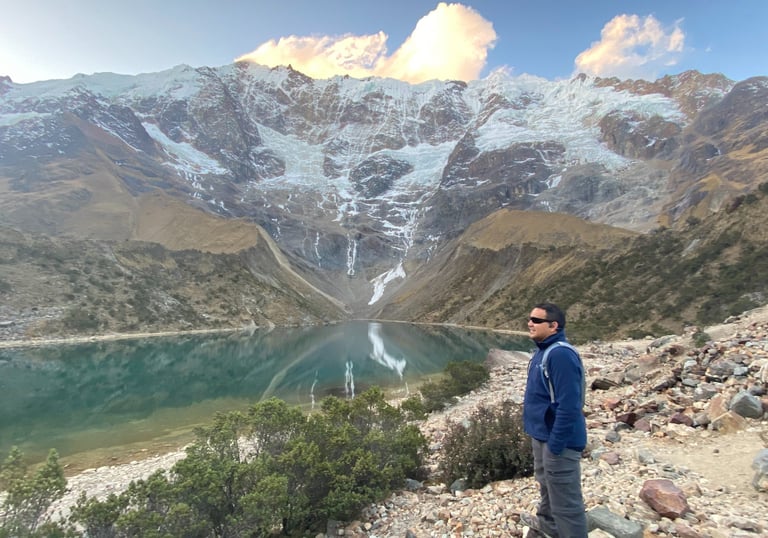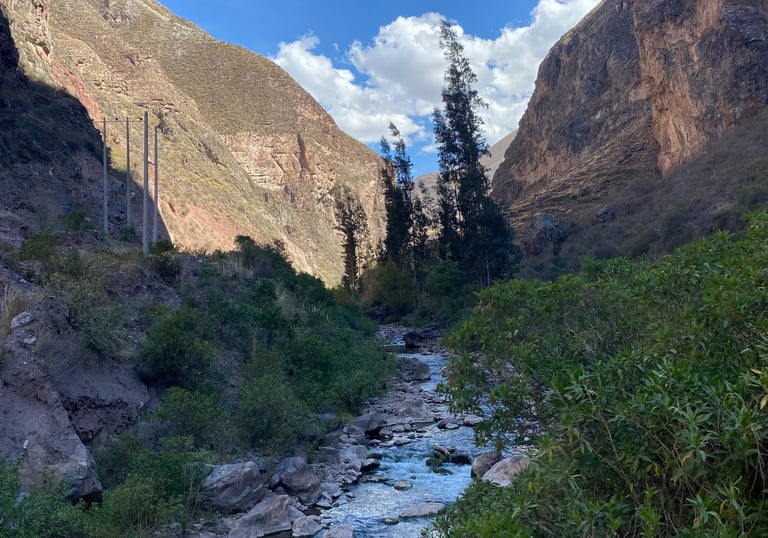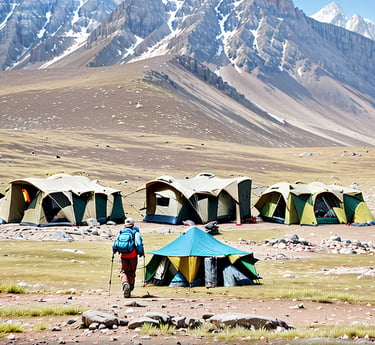ANDEAN EXPLORER TOURS - BOOK WITH CONFIDENCE - ENGLISH/NEDERLANDS/ESPAÑOL

The Inca Trail vs The Salkantay Trek
Hiking to Machu Picchu is a bucket-list adventure, and there are two standout routes that travellers can choose: The Inca Trail vs The Salkantay Trek Each route offers a unique perspective on Peru’s landscapes, history, and culture. Our guide will help you decide which is the perfect adventure.
COMPARING APPLES WITH APPLES
Kenny P
10/27/20245 min read


Hiking to Machu Picchu is a bucket-list adventure, and there are two standout routes that travelers can choose: the classic Inca Trail and the rugged Salkantay Trek. Each route offers a unique perspective on Peru’s landscapes, history, and culture, catering to different levels of challenge, scenery preferences, and personal experiences. Here’s an in-depth look at what distinguishes the Inca Trail from the Salkantay Trek to help you decide which is the perfect adventure for you.
1. Historical Significance and Cultural Richness
The Inca Trail
The Inca Trail is the quintessential Machu Picchu pilgrimage, closely connected to the history and culture of the Incas. The 4-day trek follows ancient stone paths once used by the Incas themselves, providing a firsthand encounter with Peru’s cultural heritage. As you hike, you’ll pass through several archaeological sites, such as Llactapata, Runkurakay, Sayacmarca, and Wiñay Wayna, giving you a taste of Inca engineering and architectural prowess before reaching Machu Picchu. The journey feels like a step back in time, providing a tangible link to the past with cultural insights at every turn.
The Salkantay Trek
While the Salkantay Trek is less historically connected to the Incas, it offers an authentic Andean cultural experience. The route takes you through remote highland villages where you may encounter Quechua-speaking locals and witness their traditional way of life. This trek offers a unique immersion into Andean culture, highlighting Peru’s indigenous heritage and the close-knit communities that inhabit the region. If you're interested in engaging with local people and seeing their daily lives up close, Salkantay is ideal.
2. Scenery and Landscape
The Inca Trail
The scenery along the Inca Trail is breathtaking, featuring lush cloud forests, verdant valleys, and sub-tropical ecosystems. This trek offers a balance of beautiful, diverse landscapes in a relatively moderate altitude range. You'll traverse green mountainsides, bamboo groves, and misty forests before your first glimpse of Machu Picchu at the famous Sun Gate (Inti Punku). While it’s not as high as the Salkantay Trek, the Inca Trail’s ecosystem variety is captivating and allows hikers to experience different terrains in a relatively short distance.
The Salkantay Trek
The Salkantay Trek is renowned for its wild, remote beauty and striking alpine landscapes. The trek crosses the imposing Salkantay Pass at over 4,600 meters (15,200 feet), the highest point along the route. You’ll hike past snowy peaks, glacial lakes, and eventually descend into tropical jungles on the way to Aguas Calientes. The trek’s scenery is diverse but emphasizes dramatic, rugged landscapes, making it a great choice for those looking for sweeping mountain views and an escape into raw wilderness.
3. Level of Difficulty and Trek Conditions
The Inca Trail
The Inca Trail is a moderately challenging trek with some steep ascents and descents but remains accessible to most hikers with average fitness levels. The trek covers about 42 kilometers (26 miles) over four days, with the highest altitude point at Dead Woman’s Pass, reaching 4,215 meters (13,828 feet). The trail’s well-paved paths, comfortable campsites, and guided group structure make it a manageable, albeit physically demanding, adventure. Permits are required and strictly regulated, so booking months in advance is essential.
The Salkantay Trek
Known as the more challenging option, the Salkantay Trek demands higher levels of endurance and fitness, covering 60 to 75 kilometres (37 to 46 miles) depending on the route chosen. The Salkantay Pass pushes hikers to extreme altitudes and rugged paths that are less manicured than those on the Inca Trail. With fewer amenities and less infrastructure, Salkantay Trek presents a tougher, more adventurous journey for those ready to tackle a remote, high-altitude trail.
4. Availability and Accessibility
The Inca Trail
Because it’s such a popular and historically regulated route, the Inca Trail requires permits that can sell out months in advance, particularly for high season (May to September). Only licensed tour companies can guide you along the trail, and spaces are capped to preserve the route’s environment. This means that planning and booking far ahead is essential if the Inca Trail is on your itinerary.
The Salkantay Trek
The Salkantay Trek is far more accessible than the Inca Trail, with no strict permit requirements. You can often book the Salkantay Trek on shorter notice, making it a great option if you have a flexible schedule. While the trail is not as heavily monitored, opting for a guided trek is still advisable for safety, navigation, and cultural immersion, particularly for travellers unfamiliar with the Andean highlands.
5. Environmental Impact and Conservation
The Inca Trail
To protect the Inca Trail’s heritage and environment, there are strict guidelines on group size, waste disposal, and camping sites. These rules help minimize the environmental impact of thousands of yearly visitors, ensuring future generations can enjoy this UNESCO World Heritage Site. However, the trail’s popularity means it can feel crowded, especially in peak season.
The Salkantay Trek
With fewer regulations and less foot traffic, the Salkantay Trek offers a more secluded, less-impacted wilderness experience. The path’s remoteness and fewer hikers contribute to a quieter and more environmentally gentle experience. However, because of limited regulation, trekkers must be mindful of sustainability practices, respecting the untouched nature of the landscape to preserve it.
6. Highlights and Ending Experience
The Inca Trail
One of the most significant draws of the Inca Trail is the approach to Machu Picchu itself. Hikers arrive at the Sun Gate at dawn, with the first sight of Machu Picchu framed by sunrise over the Andes—a dramatic, unforgettable moment. This iconic ending provides a powerful emotional climax to the journey, especially with the historical trail that leads you right into Machu Picchu’s heart.
The Salkantay Trek
Unlike the Inca Trail, the Salkantay Trek concludes with a journey by bus or train from the town of Aguas Calientes to Machu Picchu. While it doesn’t offer the dramatic Sun Gate entry, the Salkantay route leads you through diverse ecosystems, from snow-capped peaks to humid jungles. This build-up still makes Machu Picchu feel like a well-earned reward and a serene way to cap off days of challenging adventure.
Which One Should You Choose?
Both treks offer awe-inspiring landscapes and an unforgettable approach to Machu Picchu, yet they cater to diverse types of travellers.
Choose the Inca Trail if you’re drawn to historical sites, prefer well-established paths with comfortable camping facilities, and don’t mind the need for advance permits. It’s a great choice if you’re looking for a blend of culture, history, and scenic variety on a moderately challenging hike.
Choose the Salkantay Trek if you’re an adventurous spirit seeking remote wilderness, willing to tackle high altitudes and rugged conditions, and appreciate the opportunity to book on shorter notice. It’s ideal for those who want a quieter experience and a taste of Peru’s natural diversity without the structured, permit-regulated environment of the Inca Trail.
Ultimately, both treks allow for unique perspectives on the Andean landscape and culture, making your journey to Machu Picchu personal and memorable. Whether through history-laden stone pathways or remote highland passes, both the Inca Trail and the Salkantay Trek offer a journey like no other.


Related Tours

Follow Us:
Stay up to date. Join our newsletter
© 2024. All rights reserved


Call Us:
Australia: +61 488428633
Peru: +54 913141019
RUC: 10101210273
Email Us:
Meet Us:
Merewether NSW 2291, Australia
C.H Hilario Mendivil 2E, IIA, 402 Cusco Peru


© 2024. All rights reserved. 'Discover the Andes', trading as Andean Explorer Tours
ABN: 52683171468
